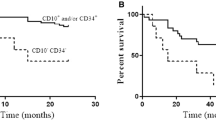Abstract
Up till now, clinical data on the possible prognostic influence of multidrug resistance (MDR) in hematological malignancies have been inconsistent, probably due to technical pitfalls. Moreover, in most studies qualitative information on the presence/absence of MDR-1 expression has been used instead of quantitative results. In addition, results usually refer to the total BM population and not specifically to blast cells. In the present study we analyzed the expression of MDR-1 in a series of 50 newly diagnosed de novo AML using a double-staining technique: (a) monoclonal antibodies for the specific identification of blast cells and (b) the rhodamine-123 efflux assay, which allows a quantitative and calibrated measurement of MDR-1 function. Expression of MDR-1 was correlated with clinical, biological, and immunophenotypical disease characteristics. All patients were uniformly treated according to the AML 87/91 protocols of the Spanish Pethema Cooperative Group; the median age was 51±19 years and the FAB distribution was as follows: 2 M0, 9 M1, 9 M2, 12 M3, 11 M4, 5 M5, and 2 M6 cases. Upon grouping the 50 AML patients analyzed according to the level of rh123 elimination, it was observed that those cases with ≥30% decrease in rh123 fluorescence displayed higher WBC counts (9±12 vs 37±73×109/l, p=0.02) and platelet numbers (94±11 vs 35±25×109/l, p=0.02), together with a higher incidence of extramedullary involvement (35% vs 24%, p=0.02). Half of the patients (47%) displaying a low rh123 elimination (<30%) showed M3 morphology, while among the 33 patients with a higher rate of rh123 elimination (≥30%), only four (12%) corresponded to the M3 morphological subtype (p=0.0006). From the immunophenotypic point of view, a low rate of rh123 elimination was associated with a lower expression of HLADR antigen (p=0.003) and a higher expression of CD117 (p=0.01). Regarding the possible prognostic influence of MDR1 expression, we found that a high rate of rh123 elimination (>30%) was associated with a tendency towards poor disease outcome, illustrated by both a lower complete remission rate with the first cycle of chemotherapy (36% vs 56%) and a lower median disease-free survival (22 months vs median DFS not reached), although differences did not reach statistical significance (p=0.1 in both comparisons). This data shows that although MDR-1 can be a relevant parameter in the evaluation of AML patients, larger series of patients using appropiate techniques for specifically analyzing the MDR of blast cells will be necessary in order to establish the final clinical value of this parameter.
Similar content being viewed by others
Author information
Authors and Affiliations
Additional information
Received: 24 April 1997 / Accepted: 25 June 1997
Rights and permissions
About this article
Cite this article
Martínez, A., Miguel, J., Valverde, B. et al. Functional expression of MDR-1 in acute myeloid leukemia: correlation with the clinical-biological, immunophenotypical, and prognostic disease characteristics. Ann Hematol 75, 81–86 (1997). https://doi.org/10.1007/s002770050318
Issue Date:
DOI: https://doi.org/10.1007/s002770050318




